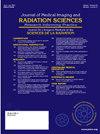Investigation of IVIM diffusion weighted MRI in muscles of the lower limb at rest
IF 2
Q3 RADIOLOGY, NUCLEAR MEDICINE & MEDICAL IMAGING
Journal of Medical Imaging and Radiation Sciences
Pub Date : 2025-07-01
DOI:10.1016/j.jmir.2025.102055
引用次数: 0
Abstract
Aim
Intravoxel incoherent motion diffusion-weighted magnetic resonance imaging (IVIM DW-MRI) provides a means for non-invasive, simultaneous assessment of tissue water diffusion and perfusion characteristics without the need for contrast agent administration. In this study, we aim to analyse the differences in water perfusion and diffusion in the lower limb calf muscles of healthy human volunteers and clinically diagnosed patients with Peripheral Arterial Disease (PAD) with acquired IVIM MR images.
Methods
15 healthy subjects with no mobility issues and 9 clinically diagnosed PAD patients were included in this study. The axial MR images were acquired on the 3T Siemens Biograph mMR (Siemens Healthineers, Germany), with a 12-channel external phased-array coil covering both legs and positioned around the midpoint of the lower leg. Structural T1-weighted images were acquired before a set of baseline (BL) and high-quality (HQ) DWI images which were subsequently registered against each other. BL scan used 16 b-values, with a scan time of 2.5 minutes while HQ scan used 10 b-values with multiple averages to increase the signal-to-noise-ratio (SNR) for the images to be clinically acceptable with a scan time of 7.5 minutes. We utilised an open-source software, Medical Imaging Interaction Toolkit, MITK (version 2018.04.2), to segment the structural T1 images of the lower limb into five muscle groups; tibialis anterior (TA), peroneal muscles (PER), deep posterior calf muscles (DP), soleus muscle (SOL) and the gastrocnemius muscle (GM) regions. An in-house coded MATLAB script was then used to extract the Apparent Diffusion Coefficient (ADC) imaging parameter using the mono-exponential model, perfusion fraction (f), diffusion coefficient (D) and pseudo-diffusion (D*) imaging parameters from the 2-step, fixed D, Intravoxel Incoherent Motion (IVIM) model of the DWI images. Intraclass Correlation Coefficients (ICC) and Mann-Whitney U test were used to evaluate quantitative reproducibility of the paired BL and HQ images, and to determine significant differences between healthy subjects and PAD patients respectively.
Results
Our study found that the parameters f, D, and ADC demonstrated moderate to excellent reproducibility (Healthy ICC:0.694, 0.913, 0.623, PAD ICC:0.715, 0.991, 0.819 respectively), while D* showed weak reproducibility (Healthy ICC:0.344, PAD ICC:0.552) with the potential for future investigation. Imaging parameters ADC and f were found to be statistically significant (p-value < 0.05) when comparing across healthy subjects and PAD patients in BL and HQ scans, indicating these parameters' potential utility as imaging biomarkers to distinguish healthy subjects from clinically diagnosed PAD patients.
Conclusion
From the results of this pilot study, the quantitative parameters obtained by the BL and HQ scans were reproducible except for D*. The results also show that ADC and f are useful imaging parameters in distinguishing between healthy and PAD patients, supporting their potential use as non-invasive imaging biomarkers to characterise restricted diffusion and impaired microvascular perfusion in the lower limbs.
静息时下肢肌肉IVIM扩散加权MRI的研究
目的:travoxel非相干运动扩散加权磁共振成像(IVIM DW-MRI)提供了一种无创、同时评估组织水扩散和灌注特征的方法,而无需使用造影剂。在这项研究中,我们旨在通过获得的IVIM MR图像分析健康人类志愿者和临床诊断为外周动脉疾病(PAD)的患者下肢小腿肌肉的水灌注和扩散的差异。方法选取15例无活动障碍的健康受试者和9例临床诊断为PAD的患者。轴向MR图像在3T Siemens Biograph mMR (Siemens Healthineers, Germany)上获得,12通道外部相控阵列线圈覆盖两条腿,位于小腿中点周围。在一组基线(BL)和高质量(HQ) DWI图像之前获得结构t1加权图像,然后相互配准。BL扫描使用16个b值,扫描时间为2.5分钟;HQ扫描使用10个b值,多次平均,以提高图像的信噪比(SNR),使其在7.5分钟的扫描时间内达到临床可接受的水平。我们使用开源软件医学成像交互工具包MITK(版本2018.04.2),将下肢的T1结构图像分割为五个肌肉群;胫前肌(TA)、腓骨肌(PER)、小腿深后肌(DP)、比目鱼肌(SOL)和腓肠肌(GM)区域。然后使用内部编码的MATLAB脚本,利用单指数模型、灌注分数(f)、扩散系数(D)和伪扩散(D*)成像参数,从DWI图像的两步固定D内像素非相干运动(IVIM)模型中提取表观扩散系数(ADC)成像参数。采用类内相关系数(Intraclass Correlation Coefficients, ICC)和Mann-Whitney U检验来评估配对的BL和HQ图像的定量再现性,并分别确定健康受试者和PAD患者之间的显著差异。结果f、D、ADC具有中等至优异的重复性(健康ICC分别为0.694、0.913、0.623,PAD ICC分别为0.715、0.991、0.819),而D*具有较弱的重复性(健康ICC为0.344,PAD ICC为0.552),具有进一步研究的潜力。成像参数ADC和f具有统计学意义(p值<;在BL和HQ扫描中比较健康受试者和PAD患者时,0.05),表明这些参数作为区分健康受试者和临床诊断的PAD患者的成像生物标志物的潜在效用。结论从本中试研究的结果来看,除D*外,BL和HQ扫描获得的定量参数是可重复的。结果还表明,ADC和f是区分健康和PAD患者的有用成像参数,支持它们作为表征下肢扩散受限和微血管灌注受损的非侵入性成像生物标志物的潜力。
本文章由计算机程序翻译,如有差异,请以英文原文为准。
求助全文
约1分钟内获得全文
求助全文
来源期刊

Journal of Medical Imaging and Radiation Sciences
RADIOLOGY, NUCLEAR MEDICINE & MEDICAL IMAGING-
CiteScore
2.30
自引率
11.10%
发文量
231
审稿时长
53 days
期刊介绍:
Journal of Medical Imaging and Radiation Sciences is the official peer-reviewed journal of the Canadian Association of Medical Radiation Technologists. This journal is published four times a year and is circulated to approximately 11,000 medical radiation technologists, libraries and radiology departments throughout Canada, the United States and overseas. The Journal publishes articles on recent research, new technology and techniques, professional practices, technologists viewpoints as well as relevant book reviews.
 求助内容:
求助内容: 应助结果提醒方式:
应助结果提醒方式:


